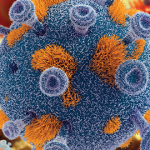HIV-associated arthritis: HIV-associated arthritis epitomizes some of the central questions and challenges that surround the treatment of rheumatic symptoms in patients with HIV. Currently, researchers are actively debating whether HIV-arthritis should be regarded as a distinct clinical entity or whether it is simply a coincidental finding in patients who are HIV positive.1
It has been categorized as an acute arthritis that presents as an asymmetric oligo arthritis, symmetrical polyarthritis or a monoarthritis. The symmetrical polyarthritis form closely resembles rheumatoid arthritis. The asymmetric, oligo variation may be the more common form, affecting primarily the knees and ankles. It is a short-lived syndrome peaking in intensity in one to six weeks. Antinuclear antibody, rheumatoid factor and HLA-B27 are all negative, and there are no other classical features that would group them in with another recognized inflammatory arthropathy.1,4
Painful-articular syndrome: This is an extremely painful, but very short-lived syndrome without synovitis or signs of inflammation. It is described as usually affecting the knees, shoulders or elbows, although smaller joints can also be affected. Case studies have reported incidences as high as 10% in patients with late-stage HIV, but other studies have not reported any cases. The syndrome continues to be reported in the cART era. Some researchers speculate that the syndrome may be a feature of specific populations or conditions that are not currently known, such as HIV contracted through intravenous drug use.1,4
DILS: The rare disorder diffuse infiltrative lymphocytosis syndrome (DILS) is similar to Sicca syndrome, but is associated with HIV infection. The condition causes salivary gland swelling, chronic sicca symptoms and sometimes extraglandular manifestations. These patients are negative for anti-Ro/SSA and anti-La/SSB, with CD8+ infiltration of glandular tissue. It was commonly reported in the pre-cART era, but it may now currently be underdiagnosed. Effective cART often improves symptoms, but DILS may relapse even with adequate therapy.4,17

Dr. Calabrese
IRIS: Immune reconstitution inflammation syndrome (IRIS) is an important phenomenon to consider after initiation of cART therapy. It is an overwhelming inflammatory response linked to rapidly recovering immune systems. In HIV, it seems to be linked to increases in CD4+ T-helper and CD8+ T-suppressor cells. Paradoxically, certain immune and autoimmune conditions can worsen after therapy begins, including sarcoidosis, lupus, myositis and rheumatoid arthritis.18 Symptoms may begin days to months after therapy begins. Most of these cases resolve spontaneously, but at times they can become life-threatening in severity, necessitating other interventions. Usually, it is not necessary to stop antiretroviral therapy during this time.18 Dr. Calabrese notes that just being aware of the condition helps clinicians, since IRIS is usually self-limiting and should not need lifelong therapy.
Many patients have unrelated rheumatic symptoms that need treatment, but others have symptoms from syndromes triggered by HIV. These may be caused by the illness itself, or secondarily through medication side effects, such as myopathy from zidovudine.
Rheumatic Conditions with Specific Characteristics in HIV-Positive Patients
Additionally, vast arrays of rheumatic conditions may have specific characteristics in the HIV-positive person and may occur with higher frequencies in certain HIV-positive populations. These include spondyloarthropathies, reactive arthritis, myositis, psoriatic arthritis, rheumatoid arthritis and systemic syndromes, such as lupus and vasculitis. These have been extensively reviewed.1,3-7


